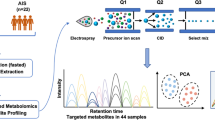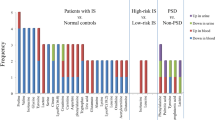Abstract
Metabolomics may identify biomarkers for acute ischemic stroke (AIS). Previously, circulating metabolites were compared in AIS and healthy controls without accounting for stroke size. The goal of this study was to identify metabolites that associate with the volume of AIS. We prospectively analyzed 1554 serum metabolites in the acute (72 h) and chronic (3–6 months) stages of 60 ischemic stroke patients. We calculated infarct volume using diffusion-weighted images with MR segmentation software and associated the volume with stage-specific metabolites, acute-to-chronic stage changes, and multiple mixed regression in metabolite concentrations using multivariate regression analysis. We used the two-stage Benjamini and Hochberg (TSBH) procedure for multiple testing. Four unknown metabolites at the acute stage significantly associated with infarct volume: X24541, X24577, X24581, and X2482 (all p < 0.01). Nine metabolites at the chronic stage are significantly associated with infarct volume: indolpropinate, alpha ketoglutaramate, picolinate, X16087, X24637, X24576, X24577, X24582, X24581 (all p < 0.048). Infarct volume is also associated with significant changes in serum concentrations of twenty-seven metabolites, with p values from 0.01 to 1.48 × 10−7, and on five metabolites using mixed regression model. This prospective pilot study identified several metabolites associated with the volume of ischemic infarction. Confirmation of these findings on a larger dataset would help characterize putative pathways underlying the size of ischemic infarction and facilitate the identification of biomarkers or therapeutic targets.


Similar content being viewed by others
Data Availability
All data are available on request.
References
Virani SS, Alonso A, Benjamin EJ, Bittencourt MS, Callaway CW, Carson AP, et al. Heart disease and stroke statistics-2020 update: a report from the American Heart Association. Circulation. 2020;141(9):e139–596.
Powers WJ, Rabinstein AA, Ackerson T, Adeoye OM, Bambakidis NC, Becker K, et al. 2018 guidelines for the early management of patients with acute ischemic stroke: a guideline for healthcare professionals from the American Heart Association/American Stroke Association. Stroke. 2018;49(3):e46–e110.
Albers GW, Goyal M, Jahan R, Bonafe A, Diener HC, Levy EI, et al. Ischemic core and hypoperfusion volumes predict infarct size in SWIFT PRIME. Ann Neurol. 2016;79(1):76–89.
Sidorov E, Sanghera DK, Vanamala JKP. Biomarker for ischemic stroke using metabolome: a clinician perspective. J Stroke. 2019;21(1):31–41.
Santucci JA, Ross SR, Greenert JC, et al. Radiological estimation of intracranial blood volume and occurrence of hydrocephalus determines stress-induced hyperglycemia after aneurysmal subarachnoid hemorrhage. Transl Stroke Res. 2018. https://doi.org/10.1007/s12975-018-0646-7.
National Institute of Neurological D, Stroke rt PASSG. Tissue plasminogen activator for acute ischemic stroke. N Engl J Med. 1995;333(24):1581–7.
LaCombe DM, Gordon DL, Issenberg SB, Vega A, Brocato C, Siegel M, et al. Stroke on the mend. JEMS. 2000;25(10):32–41.
del Zoppo GJ, Poeck K, Pessin MS, Wolpert SM, Furlan AJ, Ferbert A, et al. Recombinant tissue plasminogen activator in acute thrombotic and embolic stroke. Ann Neurol. 1992;32(1):78–86.
Pessin MS, Del Zoppo GJ, Estol CJ. Thrombolytic agents in the treatment of stroke. Clin Neuropharmacol. 1990;13(4):271–89.
Long T, Hicks M, Yu HC, Biggs WH, Kirkness EF, Menni C, et al. Whole-genome sequencing identifies common-to-rare variants associated with human blood metabolites. Nat Genet. 2017;49(4):568–78.
Dehaven CD, Evans AM, Dai H, Lawton KA. Organization of GC/MS and LC/MS metabolomics data into chemical libraries. J Cheminform. 2010;2(1):9.
Costa C, Maraschin M, Rocha M. An R package for the integrated analysis of metabolomics and spectral data. Comput Methods Prog Biomed. 2016;129:117–24.
Chong J, Yamamoto M, **a J. MetaboAnalystR 2.0: from raw spectra to biological insights. Metabolites. 2019;9(3):57.
Allison PD. Multiple regression : a primer. Thousand Oaks: Pine Forge Press; 1999.
Bendheim PE, Poeggeler B, Neria E, Ziv V, Pappolla MA, Chain DG. Development of indole-3-propionic acid (OXIGON) for Alzheimer’s disease. J Mol Neurosci. 2002;19(1–2):213–7.
Liu M, Zhou K, Li H, Dong X, Tan G, Chai Y, et al. Potential of serum metabolites for diagnosing post-stroke cognitive impairment. Mol BioSyst. 2015;11(12):3287–96.
Sundaram B, Aggarwal A, Sandhir R. Chromium picolinate attenuates hyperglycemia-induced oxidative stress in streptozotocin-induced diabetic rats. J Trace Elem Med Biol. 2013;27(2):117–21.
Cheng S, Shah SH, Corwin EJ, et al. Potential impact and study considerations of metabolomics in cardiovascular health and disease: a scientific statement from the American Heart Association. Circ Cardiovasc Genet. 2017;10(2):e1–e13.
Acknowledgments
This work was supported by the NIH (R01DK082766) and a Presbyterian Health Foundation Grant. The authors thank Rebecka Bourn, PhD, for writing assistance (U54GM104938). Authors thank the participants of MISS and are grateful for their contribution in this study.
Funding
This work was supported by the NIH (R01DK082766) and a Presbyterian Health Foundation Grant.
Author information
Authors and Affiliations
Corresponding authors
Ethics declarations
Conflict of Interest
The authors declare that they have no conflict of interest.
Ethics Approval
Study was approved by local IRB office.
Consent to Participate
Obtained from all participants.
Consent for Publication
Obtained from all participants.
Code Availability
R package MetaboAnalystR.
Additional information
Publisher’s Note
Springer Nature remains neutral with regard to jurisdictional claims in published maps and institutional affiliations.
Rights and permissions
About this article
Cite this article
Sidorov, E.V., Bejar, C., Xu, C. et al. Novel Metabolites as Potential Indicators of Ischemic Infarction Volume: a Pilot Study. Transl. Stroke Res. 12, 778–784 (2021). https://doi.org/10.1007/s12975-020-00876-z
Received:
Revised:
Accepted:
Published:
Issue Date:
DOI: https://doi.org/10.1007/s12975-020-00876-z




